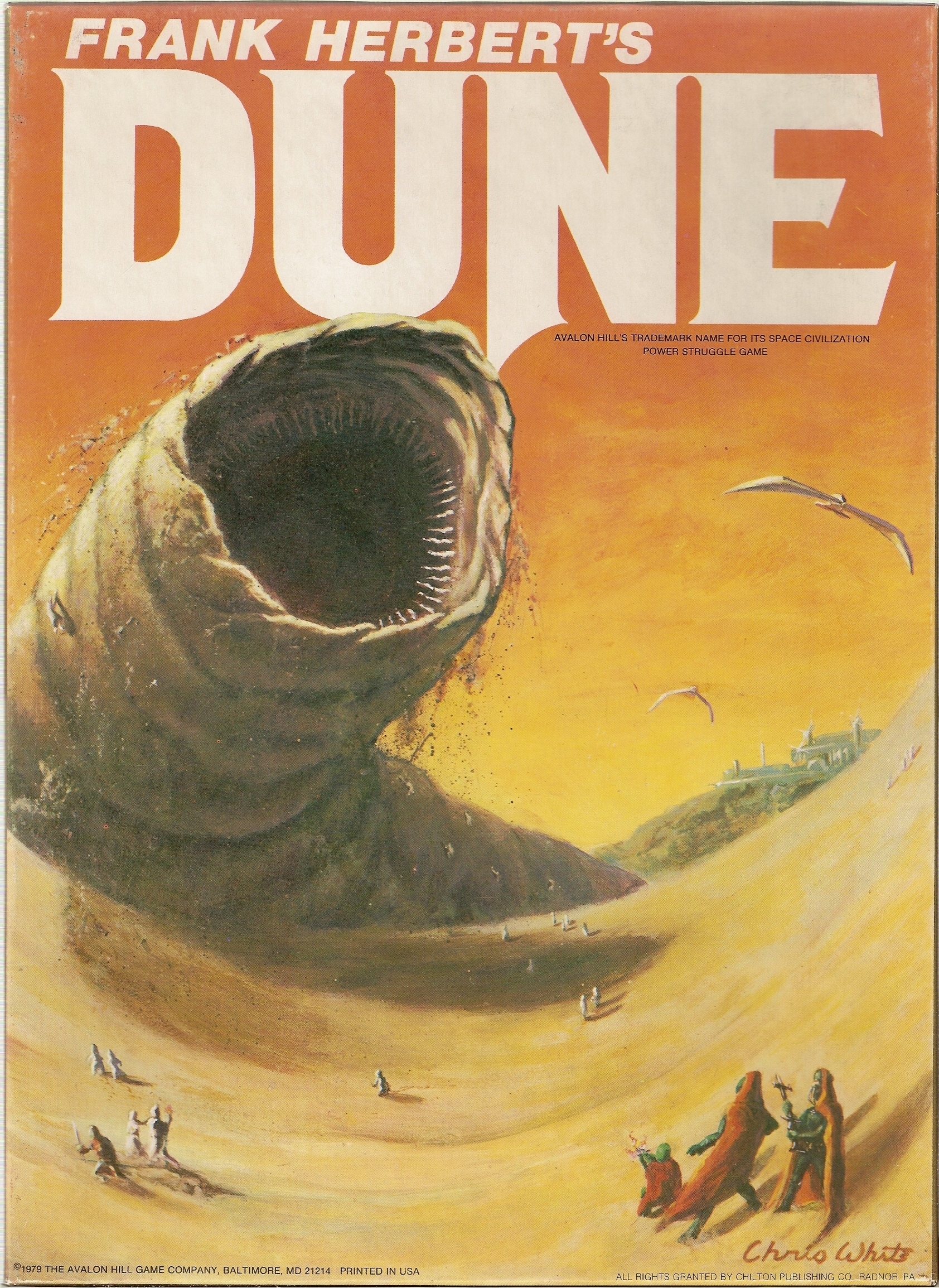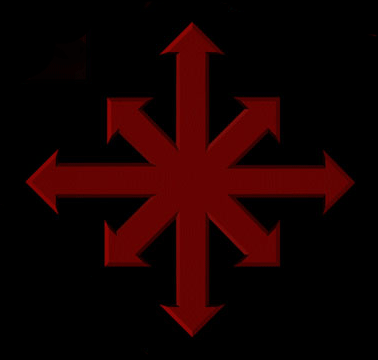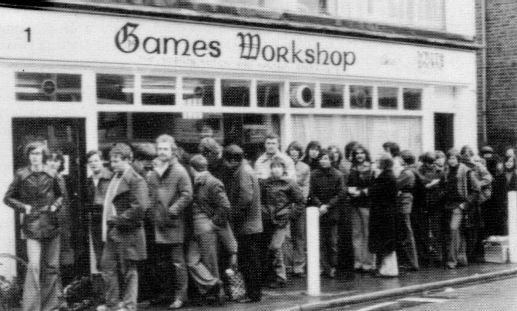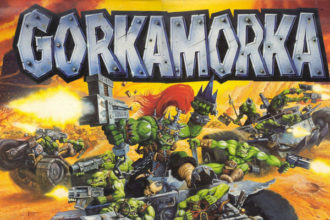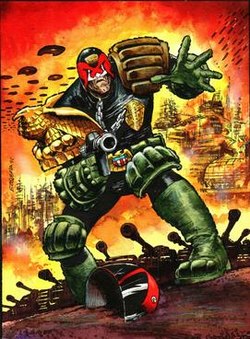On the Origin of Xenos Species: The Pop Culture Influences of Early Warhammer 40,000 – Prime
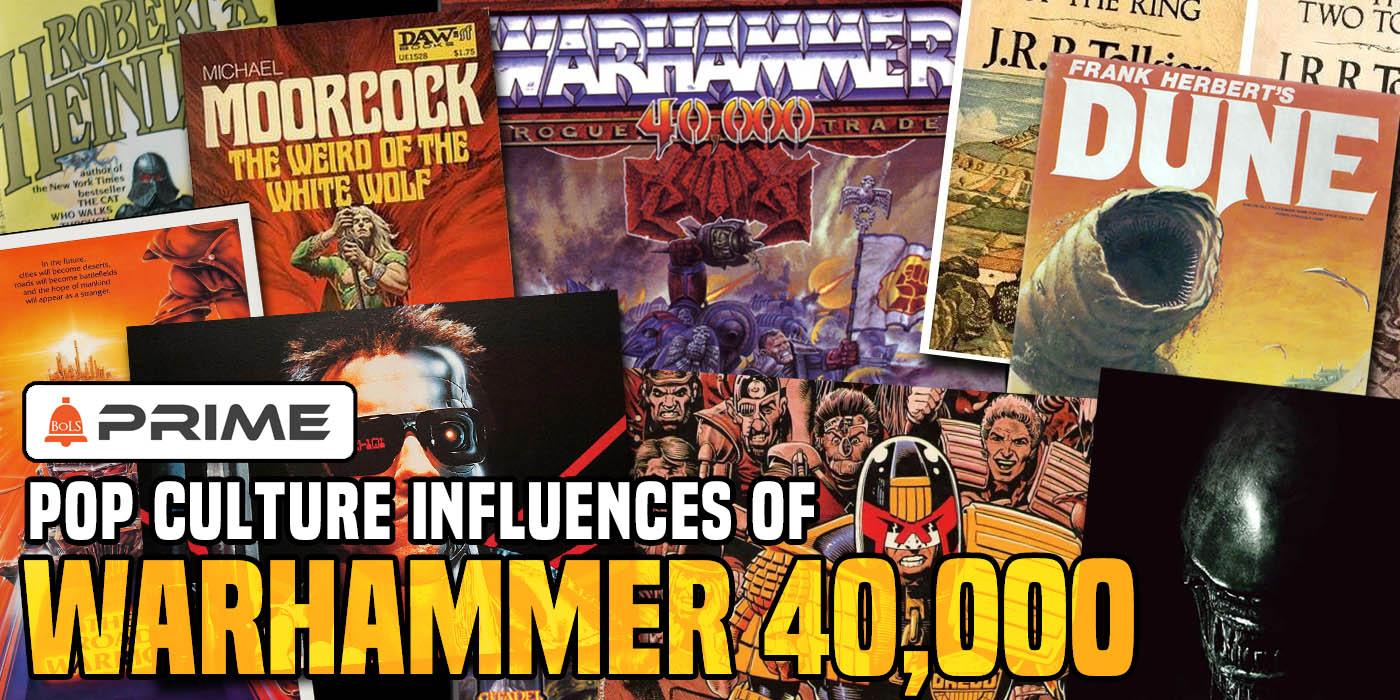

Let’s dive into the early influences that helped create Warhammer 40,000.
Warhammer 40,000 has an incredibly evocative setting filled with rich and deep lore that’s been created written over the thirty-two-year history of the game. For many people, it’s the setting, not the rules or even the miniatures, that draws them in. It’s a rich tapestry of stories and setting woven together to create something incredible. While 40K itself is an original setting and story, not all of the elements that make it up are… 100% original. Indeed Warhammer owes its existence to the vast number of sources that influenced and informed the creation of the setting, melting together ideas for many sources to form a (mostly) coherent whole.
Today I want to take a look at some of the major early influences of Warhammer. These are the things that there were borrowed from or adapted to from other sources – what we might call the DNA of the Grim Dark. By suggesting that 40K was influenced by these works, it is not at all to indicate that 40K is derivative or unoriginal. Indeed 40K draws on such a vast array of influences that it took a real genius to meld them together and make them all work, creating something truly original. Hopefully, a look at these early influences will be both interesting and informative.
Notes On Influences
The list I am going to present is not meant to be comprehensive. It would be functionally impossible to name every single influence, as this would only be known to the combined early writers and even they may have been unconscious influences by some works. Rather, I hope to present a list showing many of the major influences, though even these are at times up to interpretation.
I’ll also be limiting this to the early formative period of 40K, mostly the Rogue Trader Era and some of 2nd Edition. While Mecha Anime influenced Tau, they would be outside of our scope. I’m also looking at influences and ideas that stuck around, rather than some of those that popped up briefly and got discarded. Also, I am focusing on influences, not references. While the character Obiwan Sherlock Clousseau may reference three popular properties, I do not think most people would suggest that the Pink Panther, Sherlock Holmes, or even surprisingly Star Wars, where major influences on 40K. Lastly, I’m looking only at pop-culture influences, not historical ones. That being said, let’s take a look at things that did influence the setting.
Frank Hubert’s Dune series
Dune is often considered one of the most essential books in sci-fi history and has been an enormous influence on the genre in the decades since its publication. If any single series was a significant influence on 40K lore, it was Dune. Dune has so many things that are staples of the Warhammer setting. You’ve got a massive spacefaring human empire that still at times seems backward and has prohibited AIs, that is lead (eventually) by a mystical and powerful immortal god-emperor. You’ve got faster than light travel made possible only by mutant navigators, super-soldiers who fight for the God-Emperor, secretive mystical orders, and a feudal noble houses (in Space!). All of this is pretty much a 1-1 for the Imperium of Man, which then had some more stuff bolted on. While 40K is, in the end, vastly different from Dune, it’s clear that Hurbert’s work was the starting point for a lot of core grimdark concepts.
JRR Tolkien’s Lord of the Rings 
What hasn’t Tolkien’s work influenced? While the Lord of the Rings was a more considerable influence on Warhammer Fantasy, it also helped shape early 40K. Many of the races of 40k are directly influenced by Tolkien’s work. Eldar are similar to Tolkien’s Elves – from their look and grace to being master craftspeople to their arrogance and being a dying race. Squats, now mostly gone, were largely based on Tolkien Dwarfs, though with a bit of biker-gang thrown in. Orks are rather obviously Orcs, even down to being a manufactured race. Ratlings with their love of food, hatred of shoes, and big hairy feet are pretty obviously influenced by Hobbits. Even their penchant for thievery likely comes from the famous Hobbit burglar Bilbo Baggins.
Micheal Moorcock’s Elric of Melniboné Stories 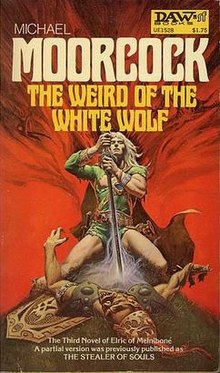
Moorcock’s Elric stories were a pioneer in the Dark Fantasy genre that 40K owes some much too. In addition to their general feel and tone, there are a lot of elements of the Elric books that seemed to have influenced 40K – in particular, the idea of Chaos. The Elric books contain many aspects of 40K’s Chaos – alternate realms, summoning, corruption, and even beings such as Arioch, and other similar beings. If Dune presented the original ideas for the Imperium, then Moorcock influenced a lot of the core of Chaos.
One crystal-clear aspect of Moorcock’s books that GW outright copied was the eight-pointed star of Chaos. In both settings, an almost identical 8-pointed star is the symbol for Chaos. GW using this symbol was certainly no accident and comes in part from a direct connection between the two settings. In the early 1980s, the game company Chaosium published an RPG called Stormbringer was based on Moorcock’s works. The RPG used the 8 pointed symbol of Chaos. Over the years, the game has been through several editions. The 3rd edition of the game was published by Chaosium in the US and was released in 1987 (the same year 40K came out). In the UK it was published by none other than a young and growing Games Workshop.
Many of the entries on this list are based on at least some conjecture, I think its safe to that the Moorcock connection is pretty indisputable. Leaving aside the popularity and influence of the Elric stories (and even if we assume that no one at GW had ever read them beforehand), we know that GW was working on publishing the RPG at the same time they were developing 40K and the Third Edition of Warhammer Fantasy Battles. All three came out in 1987.
Warhammer Fantasy 3rd Edition was also the edition of the line that really started to solidify the background and lore for WFB, much of which (especially Chaos and the Warp), carried over into 40K. The following year, 1988, GW also put out the first Realm of Chaos Book: Slaves to Darkness (followed in 1990 by The Lost and the Damned). These two books solidified the ideas of Chaos for both 40K and WFB, and borrowed heavily from Moorcock’s work, which we can say without a shadow of a doubt was well known at GW at the time.
Mad Max 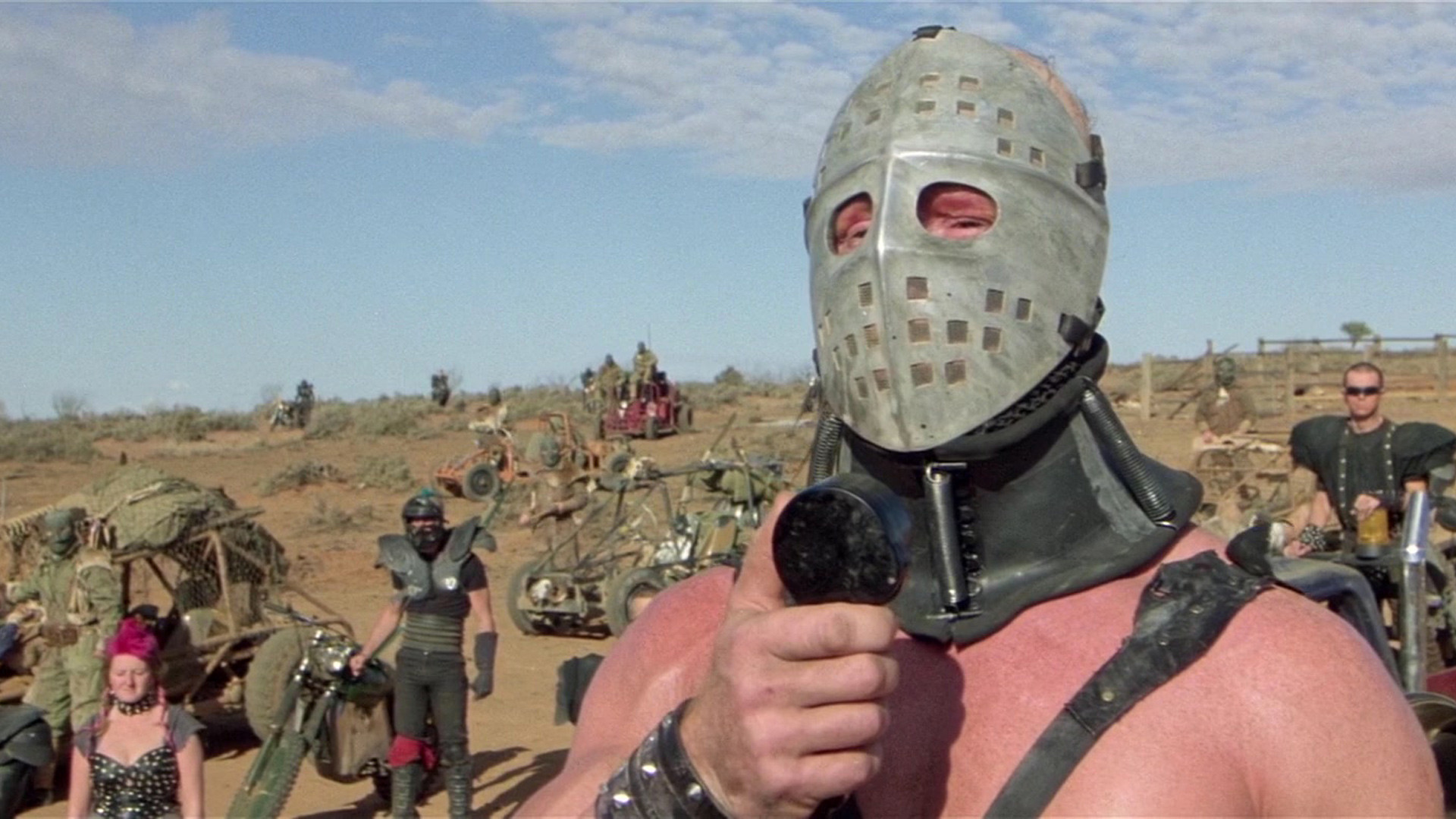
The Mad Max movies, and in particular Mad Max 2: The Road Warrior, have had an impressive impact on popular culture. The series has influenced movies, shows, books, games, and even music for decades. It’s also pretty clear it had an impact on the Warhammer 40,000 setting. The movies follow the titular Mad Max through an increasingly post-apocalyptic world, battling outlaw raider gangs across the highways and deserts of a destroyed world.
While particular plot points and lore didn’t leave many marks on 40K, the setting, visual style and aesthetic, and the humor of the movies had a pretty big influence. In particular, a huge part of the Ork race, a major antagonist in 40K, is derived from the Wastelanders in Mad Max. This includes aspects of Ork Kulture, and in particular the look and ramshackle nature of their buildings and vehicles. Speed Freaks, in particular, are pretty close analogs of the villains of the Mad Max setting (a fact not lost on converters).
The first three Mad Max movies came out between 1979 and 1985, well before Warhammer 40K was first released. Despite this, their influence doesn’t seem to have been as keenly felt in the earliest years of 40K. Arguably the biggest area they influenced was two of 40K major side games, Gorkamorka and Necromunda.
Released in 1997, Gorkamorka is more or less just a Mad Max miniatures game, with most of the humans replaced with Orks. It features gangs piloting ramshackle vehicles across vast wastelands in a battle to control resources and visually and thematically pays homage to Max. While Necromunda itself is less directly based on Mad Max, the game of rival gangs battling over territory in a dystopian industrial city draws inspiration from the series. In particular, some of the gangs draw inspiration from Mad Max, while the ash wastes that surround the major hive cities are also inspired by the setting. Though both of these were offshoots of the core 40K experience, major elements of both were eventually folded back into the more fleshed out 40K lore. 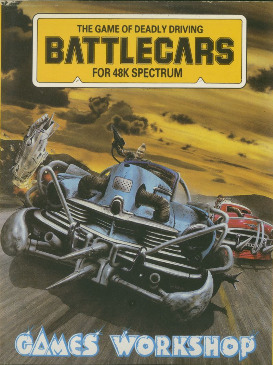
Interestingly the 40K setting is the only area that Mad Max influenced early GW. In 1983 GW put out the Battlecars wargame. Drawing heavy inspiration from Mad Max, the game featured custom-built and heavily armed cars fighting across the roadway of a post-apocalyptic future. Though Battlecars did spawn a video game, it was not much of a success.
The game was later followed in 1988 by another Games Workshop wargame, Dark Future, which featured souped-up car combat in a post-apocalyptic world. Dark Future did a little better, and even after the game went out of print GW still occasionally dabbled in the setting This included the release of a Dark Future video game earlier this year. Both of these games are considered in many ways to be prototypes for the more popular Gorkamorka. While neither directly influenced 40K, it’s clear that GW in the mid-80s, at the time 40K was in development, was very interested and influenced by Mad Max and its aesthetic, so it should be unsurprising that 40K owes a debt to Max Rockatansky.
The Alien Franchise and the Works of H.R. Giger
The Alien franchise, and in particular the first two movies, 1979’s Alien and 1986’s Aliens are another of those hugely influential works that’s DNA can be seen in 40K. The most obvious influence is in the Tyranid race – in particular, the original forerunners the Genestealers. Genestealers, which were originally their own race separate from Nids, share a huge number of similarities to the Aliens of Alien. Their look, tactics, and the reproductive cycle are similar. The influence there is clear. The 40K side game, Space Hulk (first released 1989), is a pretty clear homage to both Alien and Aliens. It features tense battles against Genestealers in an abandon ship. Later, Nid designs would continue to draw cues both from the movies and the works of H.R. Giger, which inspired the look of the movies and the infamous xenomorph.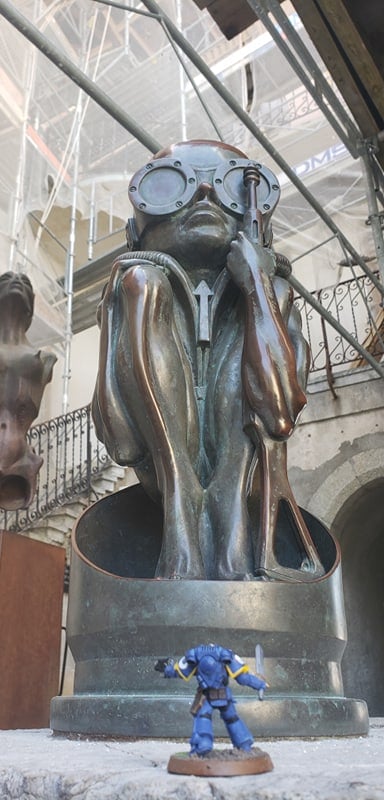
Giger’s works and the aesthetics of the franchise have influenced other aspects of 40K, as well. The stark industrial look of the many of the ships and colonies has been copied in a large part of 40K lore. The Imperial Guard (now Astra Militarium) draws influences from the Colonial Marines featured in Aliens – with some early models being based at least partially on images in the movie. Also, the idea of a small military task force stranded on a remote colony world and about to be overrun by aliens is a motif that shows up in many 40K stories.
Judge Dredd
Judge Dredd, a hugely popular British comic series set in a dystopian mega-city, is another one of those clear influences on early 40K. Dredd, which first debuted in 1977, has several key elements that GW borrowed and can be seen as a blueprint for a large part of the day-to-day Imperium of Man. This is seen in Hive Worlds, especially. If the high levels ideas for the Imperium are drawn from Dune, then the low-level detail owes much to Judge Dredd. The comic brings us the idea of mega-cities set on a world separated by wasteland, a perfect description of most hive worlds. These cities are wracked by gang warfare, endless, pitiless bureaucracy and the justices meted out by the ruthless totalitarian Judges. Strange drugs and powerful psychics can also be found.
Dredd’s influence is most keenly seen in the Necromunda spin-off game and setting, which is where its influences can be seen pretty openly. Most obvious is the Adeptus Arbites, effectively the Imperium police force, who in looks and organization are clearly based on the Judges. Thematically 40K also mirrors the social commentary and satirical elements of Dredd, which mocks extreme forms of bureaucracy, fascism and totalitarianism, and hyper-violence. 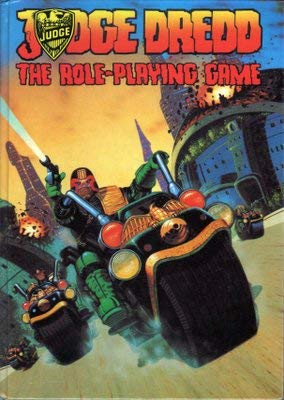
That Dredd influenced 40K is completely unsurprising for, like with the Elric stories, GW has a direct connection to Dredd. In 1985, two years before the release of 40K, Games Workshop published Judge Dredd the Role-Playing Game (whose mechanics and setting influenced the Warhammer Fantasy Role-Playing Game). The game was written by Rick Priestley and supported by games between 1985-1992, with GW finally losing the licenses in 1995. Support included two editions of the game, expansions, a board game, coverage in White Dwarf, and a line of licenses Citadel Miniatures. Rick Priestley went on to be one of the main designers of Warhammer 40,000, and with the studio both making games and miniatures in the Dredd setting, it’s unsurprising that they would have taken inspiration from it.
1980s (and early 90s) Action Movies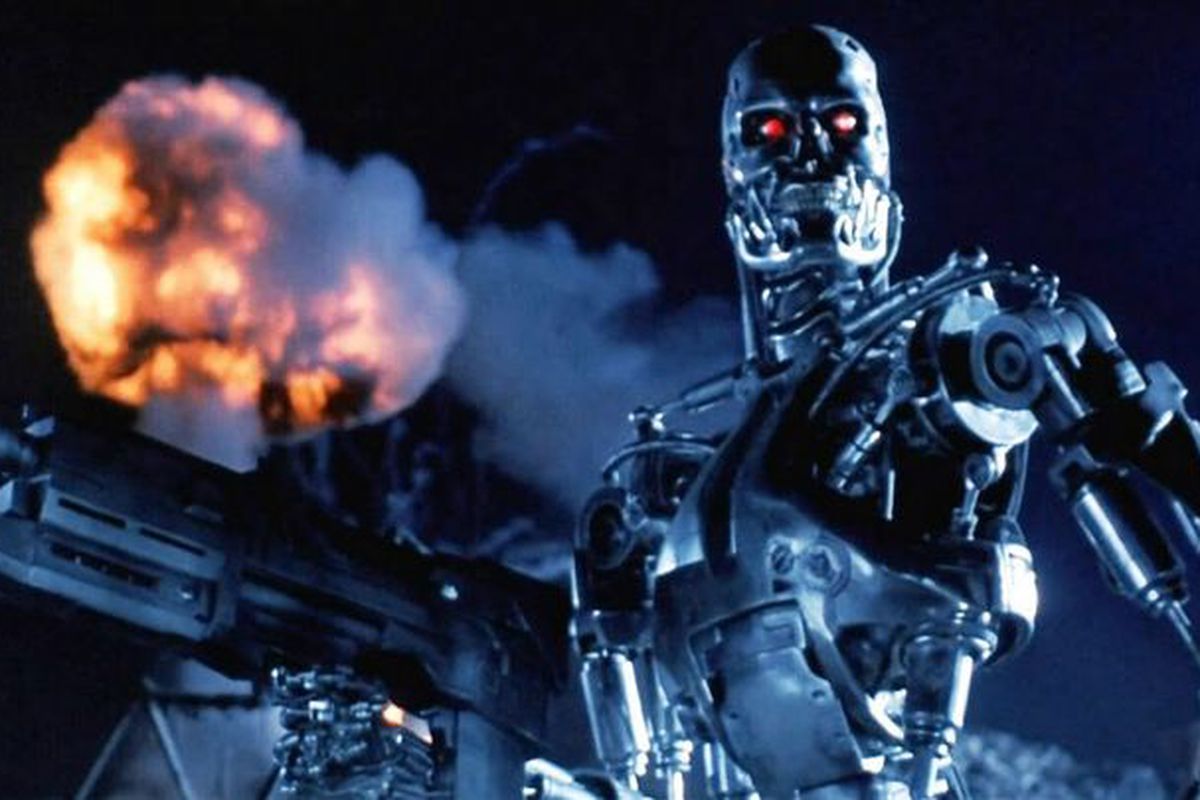
40K has drawn a lot of inspiration from action movies that came out during its formative years (and continues to do so for that matter). We’ve already discussed the effect both the Mad Max and Alien movies have had on the game. While these are likely the largest influences, many other movies have affected the game and setting.
The Terminator franchise directly inspired the Necron race and their miniature line (at least in the early days). Vietnam era movies inspired chunks of the Imperial Guard, particularly the Catachans and early Cadians. The Rambo series even got a direct nod with the character of Sly Marbo. The 1979 film The Warriors, about colorful gangs battling in a decaying New York, was likely an additional inspiration for Necromunda and its gangs. 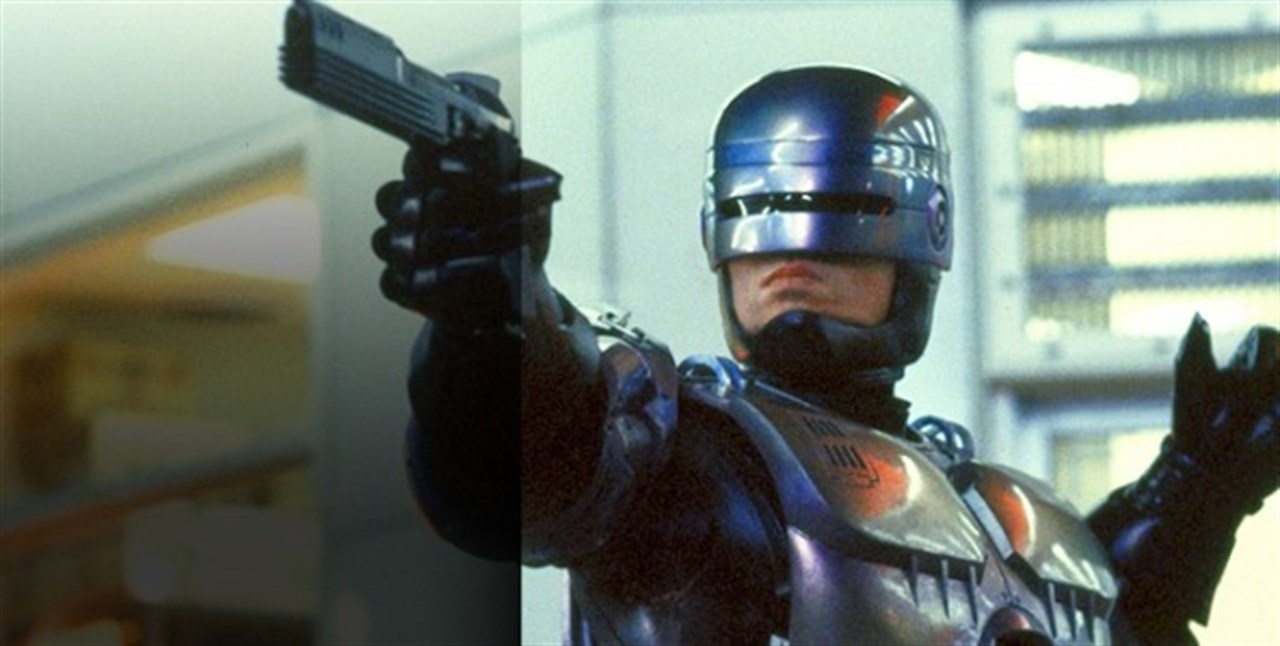
Robocop, just one of several movies dealing with cyborgs and augmented humans of the period, shared many of the same themes as the Judge Dredd stories. In particular, the idea of an augmented cyborg warrior was heavily instrumental to the ideas of the Tech Priests of Mars. These are only a few of the movies of the time that influenced 40K.
1980s British Social Commentary 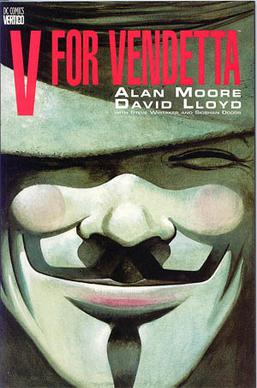
The 1980s where a pretty turbulent time in the UK, with a lot of works exploring the social issues of the time – including criticism of the government of then Prime Minister Margaret Thatcher, cold war fears, anti-war and anti-violence sentiment stirred up by The Troubles and the Falkland Island Wars, and general social worries of day where a potent breeding ground for works of political satire and commentary.
Warhammer 40,000’s setting, at least in early forms, has often been praised as a satire of fascism and hyper-violence and bureaucracy. Coming from the period it does that comes as little surprise. 40K in this regard is clearly a product of its time and location. The same things we see commented on in Dredd, are reflected in 40K, and other works from the period. Works like the well known V for Vendetta, or to a degree Watchmen, or that even found expression in comedy productions like the works of Monty Python. All of these like 40K, tired to deal and work through the major issues of the times, and all come from the same general influence, and influence each other, as 40K.
Dystopian Novels
Warhammer 40,000, and especially the Imperium of Man, is a dystopian setting. As such, the major portion of the setting is clearly influenced by some of the famous dystopian novels (and movies) to come out. Elements from 1984, Brave New World, Fahrenheit 451 and even a Clockwork Orange have all been worked into the setting. From repressive governments and surveillance states to restrictions on knowledge, and even book burning, to mental reprogramming you can see borrowed elements all over the place. It should, of course, be unsurprising that a massive dystopian star empire was based on ideas from other dystopian governments.
Akira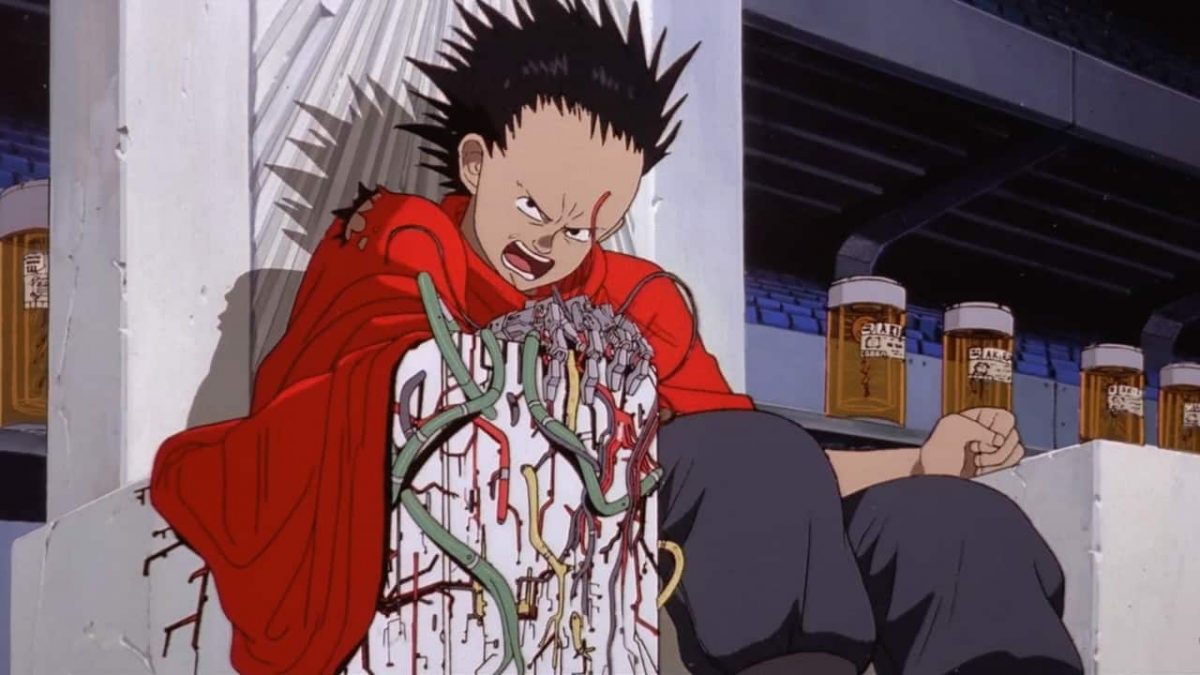
Akira, both the 1988 Anime and the 1982 Manga it was based on, are hugely influential works of art. They likely contributed ideas to early 40K as well. Neo-Tokyo, the oppressive government and wild gangs likely served as additional inspiration for hive cities and played into many themes of the era.
More importantly for 40K, you’ve got a story that deals with genetically augmented humans, cyborgs, rogue psychics and mutants, and the dangers they represent. It would not be hard at all to give Akria a quick re-write and turn it into a 40K story, with in particular the danger of uncontrolled psychics (and the ethics of state control of them) playing a major part in 40K’s setting. Heck, even the image of Tetsuo sitting on his chair up there is pretty reminiscent of images of the Emperor of Mankind on the Golden Throne.
Starship Troopers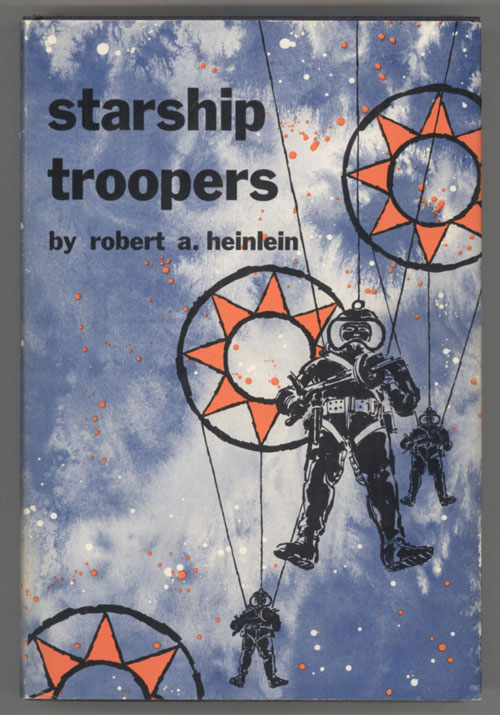
This one is a little complicated. Heinlein’s classic Starship Troopers is an incredibly influential novel and has left its mark on 40K, just not always as people think it has. GW doubtless drew inspiration directly or indirectly from the novel. The titular Starship Troopers, the Mobile Infantry, are almost certainly an influence on Space Marines, being a highly elite force equipped with powered armor. Heinlein is often credited with coming up with the idea of power armor, without which 40K would look very different. In addition, the fascist human Terran Federation is yet another inspiration for the Imperium of Man (and later Cadia). While some of the themes and tones of the novel did also contribute to 40K, it’s important to point at the novel is not a satire, and so tonally its rather off from 40K, as was its intention. Also, the alien races, such as the bugs from the novels likely didn’t have much influence on 40K. 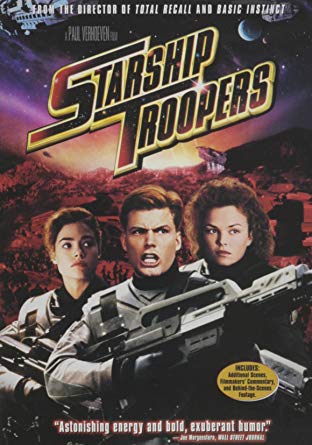
That brings us to the movie. In 1997 Paul Verhoeven, or RoboCop fame, adapted Starship Troopers into an (amazing) movie. The movie is a very different beast than the original book, with both the Mobile Infantry and the enemy Arachnids being presented differently than in the book. In typical Verhoeven style, the movie IS a satire, picking at the fascist elements or the original book and mocking overly violent and militaristic societies.
It’s hard to say at this point how the influences played out. By the time the movie came out 40K had been around for a decade and quite possibly influenced the movie itself. The movie does seem to have in turn influenced some of the later development of 40K, with the movie version of Mobile Infantry and Arachnids effecting the 3rd Editions version of the Imperial Guard and Nids. Later stories of battles between Guard and Nids have quickly obviously drawn on the visuals from the movie, and tonally the movie is much closer to the tone of early 40K than the novel. In this case, they were likely mutual inspirations are different periods of development.
Bonus: Not An Early Influence – StarCraft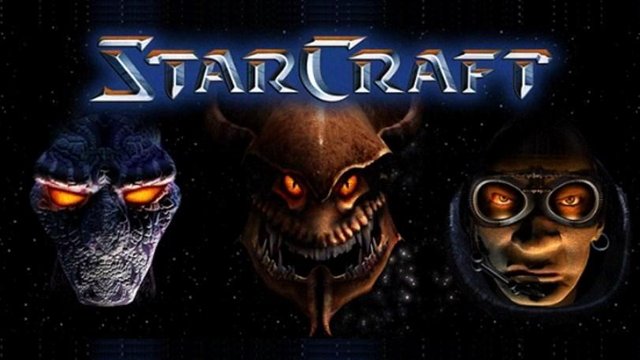
Blizzard’s hit video game StarCraft is often, erroneously, listed as a major influence on 40K. The simple fact is that StarCraft came out in 1998, 11 years after 40K and thus had no influence on the early development of the Warhammer. Instead, it’s pretty clear the StarCraft copied a great deal from 40K, from powered armored humans to a race of old powerful psychics to the devouring hive-minded bug swarm. Mind you, like with Starship Troopers, that’s not to say the GW was later influenced in turn by StarCraft. It’s perfectly plausible that later GW borrowed back ideas StarCraft had adapted or expanded on, thus enriching both franchises.
A World of Influences
Warhammer 40,000 has been influenced by, and in turn, influenced countless things. I’ve tried here to go over just some of the major pop culture influences for early Warhammer. This list is likely woefully incomplete and does not even touch on later influences or the real world historical influences of the game and setting. Still, hopefully, this list and the look at these influences provide some useful insight on the origins of the game or are at least somewhat entertaining.
Hopefully, it also lays to rest accusations that 40K is just copied from some other source. Certainly, 40K draws things from a whole host of sources, but it draws on such a massive and wide variety of inspirations, that no one major aspect is really copied. The genius of 40K was not in copying others’ work, but it blending together so many ideas and sources into a unique whole.
Furthermore, it’s interesting to note how involved GW was with many influential properties back in the day, and how this obviously led to influences seeping in. In this case, such as with Judge Dredd, it’s not simply GW copying something from another, but designers and writers creating things for one setting and then reusing similar ideas later. Ultimately nothing is created in a void. 40K was designed during a particularly rich and innovated time, in particular for British Sci-fi, and its no surprise it was influenced by its time and location. We, as fans of the setting, should count ourselves lucky that this is true, and the Warhammer had such a rich tradition to draw on.

